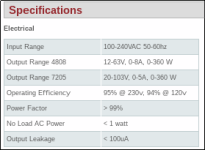xtinctionRebeller said:
[*] charging power tool batteries, perhaps some of which are ni-mh. Bicycle batteries are expensive and often people have power tool batteries on-hand. There's no reason a power tool battery can't drive an e-bike PAS.
(not part of your point, but the ebike doesn't have to be a pas, or even a low-power system.)
there's quite a few "powertool pack" builds here on es over the years.

there's even one just posted today over on the "your creation's before and after pics" thread.
Note as well that if a builder opts to wire several power tool batteries in series or parallel and toss them in a bag, it'd be a hassle to disassemble to recharge them on their factory chargers. The Cycle Satiator could lift that burden.
as long as the packs allow charging from a source other than the factory charger, yes. some packs might have a built in bms that will only accept a charge from something it can communicate with; they might also have no built-in way to turn off charging when one cell reaches full, to do balancing, and instead have to tell the charger to stop for a bit while the bms does it's thing.
but for the sake of this, we'll assume they don't, and that it is electrically safe to series the charge ports just like the discharge ports. if true, the cs can already do this, just like any other battery pack--the user just has to wire up their pack setup for this (just like any other pack built of modules).
[*] powering the motor directly. If the Cycle Satiator could function as a simple power supply, it would eliminate the need for a battery when building/testing/troubleshooting motors and sensors on a workshop bench.
it can already do this, just use "force start" (holding the bottom button, iirc).
however...many motor systems may have surge currents even with no load that far exceed what the cs can handle, especially when troubleshooting a problem like mismatched halls/phases, or other startup problems that can cause very high initial current. 8a is the limit for the most common cs, and it's even less (5a?) for the high voltage version.
but it does indeed work for some testing of a system without a battery.
[*] charging laptop batteries would be useful. I think the Cycle Satiator goes as low as 24v, which just misses the laptop range (roughly 18-20v). Someone with a 20v laptop and a 52v e-bike would have to buy two units because no single model covers that range.
dunno which cs you are referring to.
mine (the 4808, first model they came out with, and still the most common one) will charge a 12v car battery (at 14.4v, but it will go as low as 12v) (albeit not very fast, i've helped friends stuck somewhere by doing that).
i most commonly use it to charge my 4s2p 16.4v full 40ah nmc lighting pack at 8a.
then i can just change to the preset for charging my 14s2p 57.8v full 40ah at 8ah, and plug it into that, to charge the trike's traction battery.
i have presets for a number of other batteries around here, both ebike and other stuff, and have made adapters for the xlr plug for some, for the rest i use the xlr-pp45 adapter it came with and either put pp45s on the device or made an adapter for the pp45s to the device's port.
however---the laptop batteries are another instance of something that often cannot be charged without having it connected to the (working) laptop battery connector, as the bms in those also communicates with the charging circuitry in the laptop.
of course you can bypass the bms protections and charge the cells, but that's not the same thing, and the typical user isn't going to want to do that; it may involve cutting open the pack to create access to internal wiring.
if you mean simply using the cs to replace the original laptop power supply brick, then you can easily do this simply by using the "force start" mode, after you have created a profile that will support that laptop's input requirements.
[*] powering the laptop directly (in a power supply mode),
this can already be done, as noted previously, wiht the "force start" mode.
and the possibility of using either an A/C power source or a bicycle battery as a power source. E.g. you cycle to somewhere remotely to do some work on the laptop. If your laptop runs out of juice it'd be nice to have the device work as a d/c to d/c converter.
it can, as long as you have the minimum input voltage required for it, about 90vdc according to justin_le here:
https://endless-sphere.com/forums/viewtopic.php?f=14&t=60169&p=899593
most smps psus will operate on dc input as long as it is sufficient to power the input stage and cause it to oscillate, etc. i use many "wallwart" ac adapters as dc-dcs on ebike projects and the like; they usually require about 50-60vdc to turn on, for those marked as 100vac minimum. some of them need 90vdc or more to turn on, though they will often then run on a much lower voltage, sometimes as low as 50-60vdc (usually not).
keep in mind that when running the input on a dc voltage rather than ac, it will have current flowing only thru half of the input rectifier. if it's all one unit, vs individual diodes, it is unlikely to be an issue as power dissipation will still be nearly the same for the device. but if it uses individual diodes then their packages may be too small to dissipate twice the power each that they normally would, for the two that will be passing all the current (while the other pair is idle).
some of them won't work on dc at all, but they usually have something special about the way they startup that requires the ac portion of the input, like the xbox 360 psu.
And generally, how big is the market for a high-end charger for $300 that does the job of the cheap included chargers? People want some extra versatility for $300.
it has that versatility, as noted above.
also, it may replace more than $300 worth of chargers if you have a bunch of different packs that require different charge voltages and/or charge rates.







